Lithuanians
Lietuviai | |
|---|---|
 | |
| Total population | |
| c.4.2 million[1] | |
| Regions with significant populations | |
| 652,790 (2014)[a][3] | |
| 212,000 (2018)[4] | |
| 200,000 (2002)[5][6] | |
| 75,000 (2021)[7] | |
| 62,239 (2014)[6] | |
| 59,285 (2016)[8] | |
| 50,406 (2023)[9] | |
| 42,973 (2022)[7] | |
| 34,846 (2014)[6] | |
| 22,012 (2021)[b][c][11] | |
| 20,000[d][13] | |
| 19,954 (2014)[6] | |
| 19,091 (2014)[6] | |
| 17,991 (2022)[7] | |
| 17,396 (2022)[14] | |
| 16,429 (2023)[15] | |
| 13,230 (2021)[16] | |
| 10,119 (2022)[7] | |
| 10,000[17] | |
| Languages | |
| Lithuanian | |
| Religion | |
| Roman Catholicism(majority),LutheranismandIrreligion(minority) | |
| Related ethnic groups | |
| OtherBalts | |
Lithuanians(Lithuanian:lietuviai[a]) are aBaltic ethnic group.They are native toLithuania,where they number around 2,378,118 people.[2]Another two millions make up the Lithuaniandiaspora,largely found in countries such as theUnited States,United Kingdom,BrazilandCanada.Their native language isLithuanian,one of only two surviving members of theBaltic languagefamily along withLatvian.According to thecensus conducted in 2021,84.6% of thepopulation of Lithuaniaidentified themselves as Lithuanians, 6.5% asPoles,5.0% asRussians,1.0% asBelarusians,and 1.1% as members of other ethnic groups. Most Lithuanians belong to theCatholic Church,while theLietuvininkaiwho lived in the northern part ofEast Prussiaprior to World War II, were mostlyLutherans.
History[edit]
This sectionneeds expansion.You can help byadding to it.(September 2023) |


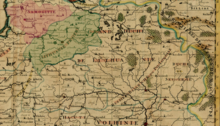
The territory of the Balts, including modern Lithuania, was once inhabited by several Baltic tribal entities (Aukštaitians,Sudovians,Old Lithuanians,Curonians,Semigallians,Selonians,Samogitians,Skalvians,Old Prussians(Nadruvians)), as attested by ancient sources and dating from prehistoric times. Over the centuries, and especially under theGrand Duchy of Lithuania,some of these tribes consolidated into the Lithuanian nation, mainly as a defence against the maraudingTeutonic OrderandEastern Slavs.The Lithuanian state was formed in theHigh Middle Ages,with different historians dating this variously between the11thandmid-13thcenturies.[18]Mindaugas,Lithuania's only crowned king and its first baptised ruler, is generally considered Lithuania's founder.[19]The Lithuanians are the only branch ofBaltic peoplethat managed to create astate entitybefore themodern era.[20][21][22]During theLate Middle Ages,Lithuania was ravaged by theLithuanian Crusade,which ended only by theTreaty of Melnoin 1422. In fact, the crusade persisted after the definiteChristianization of Lithuaniain 1387, when Europe's lastpaganpeople were baptised.[20][23]Simultaneously, the Lithuanian state reached its apogee under the rule ofVytautas the Great(r. 1392–1430), when it ruled the lands between theBalticandBlackseas. Thereafter, theGrand Duchy of Lithuaniacontinued existing until 1795, however, since theUnion of Lublinin 1569, it maintained its independence in the bi-confederalPolish–Lithuanian Commonwealth.[24]
There is a current argument that the Lithuanian language was considered non-prestigious enough by some elements in Lithuanian society, meaning that the number of Lithuanian language-speakers decreased withPolonizationin thePolish–Lithuanian Commonwealth,as well as aGermanisation of Prussia.The subsequentimperial Russianoccupation from 1795 until 1915, with some interpositions such as theFrench invasion of Russiain 1812, theUprisings of 1831and1863,accelerated this process of Slavicization. While under Russian occupation, Lithuanians enduredRussification,which included the 40-year-longban on public speaking and writing in Lithuanian(see, e.g.,Knygnešiai,the actions against the Catholic Church). In such a context, theLithuanian National Revivalbegan in the 19th century. Some believed at the time that the Lithuanian nation as such, along with its language, would become extinct within a few generations.
Some of the Polish- and Belarusian-speaking persons from the lands of the former Grand Duchy of Lithuania expressed their affiliation with the modern Lithuanian nation in the early 20th century, includingMichał Pius Römer,Stanisław Narutowicz,Oscar MiloszandTadas Ivanauskas
In February 1918, whileWorld War Iwas ongoing, there-establishment of an independent Lithuanian state was declared,122 years after it was destroyed. In theaftermath of World War I,Lithuanians militarily defended their country's independence fromPoland,WhitesandSoviet Russiaduring theLithuanian Wars of Independence.However, a third of Lithuania's lands, namely theVilnius Region,as well as its declared capital, fell under Polish occupation during theInterwar.A standardised Lithuanian language was approved. In the lead-up to the World War II, theKlaipėda Regionwas occupied byNazi Germanyafter the1939 German ultimatum to Lithuania.
"We do not know on whose merits or guilt such a decision was made, or with what we have offended Your Lordship so much that Your Lordship has deservedly been directed against us, creating hardship for us everywhere. First of all, you made and announced a decision about the land ofSamogitia,which is our inheritance and our homeland from the legal succession of the ancestors and elders. We still own it, it is and has always been the same Lithuanian land, because there isone languageand the same inhabitants. But since the land of Samogitia is located lower than theland of Lithuania,it is called as Samogitia, because inLithuanianit is called lower land [Žemaitija]. And theSamogitianscallLithuaniaasAukštaitija,that is, from the Samogitian point of view, a higher land. Also, the people of Samogitia have long called themselves Lithuanians and never – Samogitians, and because of such identity (sic) we do not write about Samogitia in our letter, because everything is one: one country and the same inhabitants. "
—Vytautas the Great,excerpt from his 11 March 1420Latinletter sent toSigismund, Holy Roman Emperor,in which he described the core of theGrand Duchy of Lithuania,composed fromŽemaitija(lowlands) andAukštaitija(highlands).[25][26]TermAukštaitijais known since the 13th century.[27]
The territory inhabited by the ethnic Lithuanians has shrunk over centuries; once Lithuanians made up a majority of the population not only in what is nowLithuania,but also in northwesternBelarus,in large areas of the territory of the modernKaliningrad Oblastof Russia, and in some parts of modernLatviaand Poland.[28]
In 1940, Lithuania was invaded and occupied by theSoviet Union,and forced to join it as theLithuanian SSR.The Germans and their allies attacked the USSR in June 1941, and from 1941 to 1944, Lithuania was occupied by Germany. The Germans retreated in 1944, and Lithuania fell under Soviet rule once again. The long-standing communities of Lithuanians in the Kaliningrad Oblast (Lithuania Minor) were almost destroyed as a result.
The Lithuanian nation as such remained primarily in Lithuania, few villages in northeastern Poland, southernLatviaand also in the diaspora of emigrants. Some indigenous Lithuanians still remain in Belarus and the Kaliningrad Oblast, but their number is small compared to what they used to be. Lithuania regained its independence in 1990, and was recognized by most countries in 1991. It became a member of theEuropean Unionon May 1, 2004.[citation needed]
Ethnic composition of Lithuania[edit]
Among theBaltic states,Lithuania has the most homogeneous population. According to the census conducted in 2001, 83.45% of the population identified themselves as ethnic Lithuanians, 6.74% asPoles,6.31% asRussians,1.23% asBelarusians,and 2.27% as members of other ethnic groups such asUkrainians,Jews,Germans,Tatars,Latvians,Romani,Estonians,Crimean Karaitesetc.
Poles are mostly concentrated in theVilnius County.Especially large Polish communities are located in theVilnius District Municipalityand theŠalčininkai District Municipality.
Despite being the capital, Vilnius was not the largest city by number of Lithuanians until mid-2000s. According to the 2011 census Vilnius had 337,000 Lithuanians whileKaunas– 316,000.[29]
Russians, even though they are almost as numerous as Poles, are much more evenly scattered. The most prominent community lives in theVisaginas Municipality(52%). Most of them are workers who moved from Russia to work at theIgnalina Nuclear Power Plant.A number of ethnic Russians left Lithuania after the declaration of independence in 1990.
In the past, the ethnic composition of Lithuania has varied dramatically. The most prominent change was the extermination of the Jewish population duringthe Holocaust.Before World War II, about 7.5% of the population was Jewish[citation needed];they were concentrated in cities and towns and had a significant influence on crafts and business. They were called Litvaks and had a strong culture. The population of Vilnius, which was sometimes nicknamed the northernJerusalem,was about 30% Jewish.[citation needed]Almost all its Jews were killed duringthe Holocaust in Nazi-occupied Lithuania,some 75,000 alone between the years 1941 – 1942,[30]while others later immigrated to the United States and Israel. Now there are about 3,200 Jews living in Lithuania.[31]

Cultural subgroups[edit]
Apart from the various religious and ethnic groups currently residing in Lithuania, Lithuanians themselves retain and differentiate between their regional identities; there are 5 historic regional groups:Žemaičiai,Suvalkiečiai,Aukštaičiai,DzūkaiandPrūsai,[32]the last of which is virtually extinct. City dwellers are usually considered just Lithuanians, especially ones from large cities such asVilniusorKaunas. The four groups are delineated according to certain region-specific traditions, dialects, and historical divisions. There are some stereotypes used in jokes about these subgroups, for example, Sudovians are supposedly frugal while Samogitians are stubborn.
Genetics[edit]
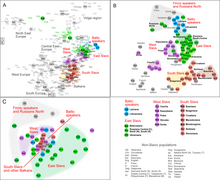
Since the lateNeolithicperiod the native inhabitants of the Lithuanian territory have not been replaced by migrations from outside, so there is a high probability that the inhabitants of present-day Lithuania have preserved the genetic composition of their forebears relatively undisturbed by the major demographic movements,[33]although without being actually isolated from them.[34]The Lithuanian population appears to be relatively homogeneous, without apparent genetic differences among ethnic subgroups.[35]
A 2004 analysis ofmtDNAin a Lithuanian population revealed that Lithuanians are close to bothIndo-EuropeanandUralic-speaking populations of Northern Europe.Y-chromosomeSNPhaplogroupanalysis showed Lithuanians to be closest to fellowBalts(Latvians),Estonians,BelarusiansandFinnish people.This is the result ofIron Age.[36]AutosomalSNP analysis situates Lithuanians most proximal toLatvians,followed by the westernmostEast Slavs,furthermore, allSlavic peoplesandGermansare situated more proximal to Lithuanians than Finns and northern Russians.[37]
LithuanianAshkenaziJews also have interesting genetics, since they display a number of unique genetic characteristics; the utility of these variations has been the subject of debate.[38]One variation, which is implicated in familialhypercholesterolemia,has been dated to the 14th century, corresponding to the establishment of Ashkenazi settlements in response to the invitation extended byVytautas the Greatin 1388.[39]
At the end of the 19th century, the average height of males was 163.5 cm (5 ft 4 in) and the average height of females was 153.3 cm (5 ft 0 in). By the end of the 20th century, heights averaged 181.3 cm (5 ft 11 in) for males and 167.5 cm (5 ft 6 in) for females.[40]
Diaspora[edit]
This sectionneeds additional citations forverification.(January 2021) |
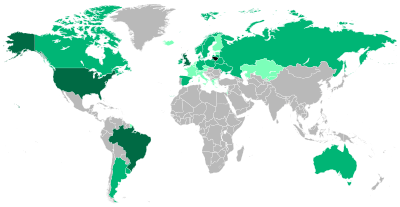
Lithuanian settlement extends into adjacent countries that are now outside the modern Lithuanian state. A small Lithuanian community exists in the vicinity ofPuńskandSejnyin theSuwałkiarea of Poland, an area associated with the Lithuanian writer and clericAntanas Baranauskas.[41] Although most of the Lithuanian inhabitants in the region ofLithuania Minorthat formed part ofEast Prussiawere expelled when the area was annexed by theSoviet Unionas theKaliningrad Oblast,small groups of Lithuanians subsequently settled that area as it was repopulated with new Soviet citizens. Small groups ofLithuanians are still present in Belaruswithin theGrodnoandVitebsk regions.[42]
Apart from the traditional communities in Lithuania and its neighboring countries, Lithuanians have emigrated to other continents during the 19th, 20th and 21st centuries.
- Communities in the United States make up the largest part of thisdiaspora;as many as one million Americans can claim Lithuanian descent. Emigration to America began in the 19th century, with the generation calling itself the "grynoriai" (derived from "greenhorn"meaning new and inexperienced).[43]The migration flow was interrupted during the Soviet occupation, when travel and emigration were severely restricted. The largest concentrations ofLithuanian Americansare in theGreat Lakesarea and the Northeast;Chicagoin particular is noted asthe primary center of the diaspora.Nearly 33,000 Lithuanians have immigrated to the United States since the fall of the Soviet Union in 1991.[44]
- Lithuanian communities in Canada are among the largest in the world along with the United States (SeeLithuanian Canadian).
- Lithuanian communities in Mexico and South America (Argentina,Brazil,Colombia,Uruguay andVenezuela) developed before World War II, beginning in the late 19th and early 20th centuries. Currently, there is no longer a flow of emigrants to these destinations, since economic conditions in those countries are not better than those in Lithuania (seeLithuanians in Brazil).
- Lithuanian communities were formed in South Africa during the late 19th and 20th century, the majority being Jewish.
- Lithuanian communities in other regions of the former Soviet Union were formed during the Soviet occupation; the numbers of Lithuanians inSiberiaand Central Asia increased dramatically when a large portion of Lithuanians were involuntarily deported into these areas. Afterde-Stalinization,however, most of them returned. Later, some Lithuanians were relocated to work in other areas of the Soviet Union; some of them did not return to Lithuania, after it became independent.
- The Lithuanian communities inUnited KingdomandIrelandbegan to appear after the restoration of independence to Lithuania in 1990; this emigration intensified after Lithuania became part of theEuropean Unionin 2004. London andGlasgow(especially theBellshillandCoatbridgeareas ofGreater Glasgow) have long had large Catholic and Jewish Lithuanian populations. The Republic of Ireland probably has the highest concentration of Lithuanians relative to its total population size in Western Europe; its estimated 45,000 Lithuanians (about half of whom are registered) form over 1% of Ireland's total population.
- The Lithuanian communities in other countries ofNorthwestern Europe(Norway, Sweden, Denmark, the Netherlands, and Iceland) as well as in Spain are very new and began their growth spurts as Lithuanian was accepted into the EU. In Norway there are 45,415 Lithuanians living in the country and it has in a short time become the second largest ethnic minority in the country, making up 0.85% of Norway's total population, and 4.81% of allforeign residentsinNorway.[45]There are around 3,500 Lithuanians inIceland,making around 1% of the total population.
- Lithuanian communities in Germany began to appear after World War II. In 1950 they founded the Lithuanian High School inDiepholz,which was a private school for children of Lithuanian refugees. For decades the Lithuanian High School was the only full-time high school outside the Eastern Bloc offering courses in Lithuanian history, language, and culture. In 1954, the Lithuanian Community acquired Rennhof Manor House with its twelve-acre park in the town of Lampertheim-Hüttenfeld. The school was relocated there and still exists today.
- Lithuanian communities in Australiaexist as well; due to its great distance from Europe, however, emigration there was minuscule. There are Lithuanian communities inMelbourne,Geelong,Sydney,Adelaide,Brisbane,HobartandPerth.
Culture and traditions[edit]
The Lithuanian national sport is usually considered to bebasketball(krepšinis), which is popular among Lithuanians in Lithuania as well as in the diasporic communities. Basketball came to Lithuania through theLithuanian-American communityin the 1930s. Lithuanian basketball teams were bronze medal winners in the1992,1996,and2000 Summer Olympics.[citation needed]
Joninės(also known asRasos) is a traditional national holiday, celebrated on the summer solstice. It has pagan origins.Užgavėnės(Shrove Tuesday) takes place on the day beforeAsh Wednesday,and is meant to urge the retreat of winter. There are also national traditions for Christian holidays such asEasterandChristmas.[citation needed]
Cuisine[edit]
Lithuanian cuisine has much in common with other European cuisines and features the products suited to its cool and moist northern climate: barley, potatoes, rye, beets, greens, and mushrooms are locally grown, and dairy products are one of its specialties. Nevertheless, it has its own distinguishing features, which were formed by a variety of influences during the country's rich history.[citation needed]
Since shared similarities in history and heritage, Lithuanians, Jews and Poles have developed many similar dishes and beverages: dumplings (koldūnai), doughnuts (spurgos), and crepes (lietiniai blynai). German traditions also influenced Lithuanian cuisine, introducing pork and potato dishes, such as potato pudding (kugelis) and potato sausages (vėdarai), as well as thebaroquetree cake known asšakotis.Traditional dishes ofLithuanian TatarsandLithuanian KaraiteslikeKibinaiandčeburekai,that are similar topasty,are popular in Lithuania.[citation needed]
For Lithuanian Americans both traditional Lithuanian dishes ofvirtinukai(cabbage and noodles) andbalandėliai(rolled cabbage) are growing increasingly more popular.[citation needed]
There are also regional cuisine dishes, e.g. traditionalkastinysinŽemaitija,Western Lithuania,Skilandisin Western and Central Lithuania,Kindziukasin Eastern and Southern Lithuania (Dzūkija).[citation needed]
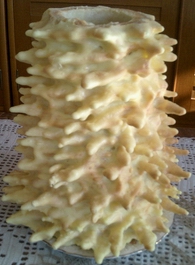
Cepelinai,a stuffed potato creation, is the most popular national dish. It is popular among Lithuanians all over the world. Other national foods include darkrye bread,cold beet soup(šaltibarščiai), andkugelis(a baked potato pudding). Some of these foods are also common in neighboring countries.Lithuanian cuisineis generally unknown outside Lithuanian communities. Most Lithuanian restaurants outside Lithuania are located in cities with a heavy Lithuanian presence.[citation needed]
Lithuanians in the early 20th century were among the thinnest people in the developed countries of the world.[46]In Lithuanian cuisine there is some emphasis on attractive presentation of freshly prepared foods.
Lithuania has been brewingmidus,a type of Lithuanianmeadfor thousands of years.[47]
Locally brewedbeer(alus),vodka(degtinė), andkvass(gira) are popular drinks in Lithuania. Lithuanian traditional beer of Northern Lithuania,Biržai,Pasvalysregions is well appreciated in Lithuania and abroad.[48]Starkais a part of the Lithuanian heritage, still produced in Lithuania.
Language[edit]
AmongIndo-European languages,Lithuanian isconservativein its grammar and phonology, retaining archaic features otherwise found only in ancient languages such asSanskrit(particularly its early form,Vedic Sanskrit) orAncient Greek.[49]Thus, it is an important source for the reconstruction of theProto-Indo-European languagedespite its late attestation (with the earliest texts dating only toc. 1500 A.D.,whereas Ancient Greek was first written down inc. 1450 B.C.).[50]There was fascination with the Lithuanian people and their language among the late 19th-century researchers, and the philologistIsaac Taylorwrote the following in hisThe Origin of the Aryans(1892):
"Thus it would seem that the Lithuanians have the best claim to represent the primitiveAryan race,as their language exhibits fewer of those phonetic changes, and of those grammatical losses which are consequent on the acquirement of a foreign speech. "[51]
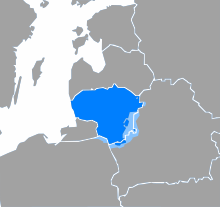
TheProto-Balto-Slaviclanguage branched off directly from Proto-Indo-European, then sub-branched intoProto-BalticandProto-Slavic.Proto-Baltic branched off into Proto-West Baltic and Proto-East Baltic.[49]Baltic languages passed through aProto-Balto-Slavicstage, from which Baltic languages retain numerous exclusive and non-exclusive lexical, morphological, phonological and accentual isoglosses in common with theSlavic languages,which represent their closest living Indo-European relatives. Moreover, with Lithuanian being so archaic in phonology, Slavic words can often be deduced from Lithuanian by regularsound laws;for example, Lith.vilkasandPolishwilk←PBSl.*wilkás(cf.PSl.*vьlkъ) ←PIE*wĺ̥kʷos,all meaning "wolf".
Literature[edit]

When theban against printing the Lithuanian languagewas lifted in 1904, various European literary movements such asSymbolism,impressionism,andexpressionismeach in turn influenced the work of Lithuanian writers. The first period of Lithuanian independence (1918–1940) gave them the opportunity to examine themselves and their characters more deeply, as their primary concerns were no longer political. An outstanding figure of the early 20th century wasVincas Krėvė-Mickevičius,a novelist and dramatist. His many works includeDainavos šalies senų žmonių padavimai(Old Folks Tales ofDainava,1912) and the historical dramasŠarūnas(1911),Skirgaila(1925), andMindaugo mirtis(The Death ofMindaugas,1935).Petras Vaičiūnaswas another popular playwright, producing one play each year during the 1920s and 1930s.Vincas Mykolaitis-Putinaswrote lyric poetry, plays, and novels, including the novelAltorių šešėly(In the Shadows of the Altars, 3 vol., 1933), a remarkably powerful autobiographical novel.
Keturi vėjaimovement started with publication ofThe Prophet of the Four Windsby talented poetKazys Binkis(1893—1942). It was rebellion against traditional poetry. The theoretical basis ofKeturi vėjaiinitially wasfuturismwhich arrived through Russia from the West and latercubism,dadaism,surrealism,unanimism,and Germanexpressionism.The most influensive futurist for Lithuanian writers was Russian poetVladimir Mayakovsky.[52]
Oskaras Milašius (1877–1939) is a paradoxical and interesting phenomenon in Lithuanian culture. He never lived in Lithuania but was born and spent his childhood in Cereja (nearMogilev,Belarus) and graduated fromLycée Janson de Saillyin Paris. His longing for his fatherland was more metaphysical. Having to choose between two conflicting countries — Lithuania and Poland — he preferred Lithuania which for him was an idea even more than a fatherland. In 1920 when France recognized the independence of Lithuania, he was appointed officially as Chargé d'Affaires for Lithuania. He published: 1928, a collection of 26 Lithuanian songs; 1930,Lithuanian Tales and Stories;1933,Lithuanian Tales;1937,The origin of the Lithuanian Nation.
Religion[edit]

Since theChristianizationof parts ofLithuania properin 1387 and ofSamogitiain 1413, the majority of Lithuanians have been members of the RomanCatholic Church.According to the 2021 census, 74% of Lithuanians are Roman Catholic.[citation needed]Under Article 26 of theConstitution of Lithuania,persons can freely practice a religion of their choosing.[53]
Catholicism played a significant role in Lithuanian anti-communist resistance under theSoviet Union.Several Catholic priests were leaders of the anti-communist movements, and thousands ofLatin crosseswere placed on theHill of CrossesnearŠiauliai,despite its being bulldozed in 1961.[citation needed]
Folk music[edit]
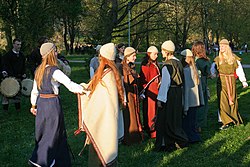
Lithuanianfolk musicis based around songs (dainos), which include romantic and wedding songs, as well as work songs and archaic war songs. These songs used to be performed either in groups or alone, and in parallelchordsorunison.Duophonicsongs are common in the renownedsutartinėstradition ofAukštaitija.Another style of Lithuanian folk music is calledrateliai,a kind ofround dance.Instrumentation includeskanklės,a kind ofzitherthat accompanies sutartinės, rateliai,waltzes,quadrillesandpolkas,andfiddles,(including a bass fiddle called thebasetle) and a kind ofwhistlecalled theLamzdeliailumzdelis;recent importations, beginning in the late 19th century, including theconcertina,accordionandbandoneon.Sutartinė can be accompanied byskudučiai,a form ofpanpipesplayed by a group of people, as well as woodentrumpets(ragaianddandytės). Kanklės is an extremely important folk instrument, which differs in the number ofstringsand performance techniques across the country. Other traditional instruments includešvilpaswhistle, drums andtabalas(a percussion instrument like agong),sekminių ragelis(bagpipe) and thepūslinė,amusical bowmade from a pig's bladder filled with dried peas.[54]
See also[edit]
- Lithuania
- Lithuania Minor
- Baltic states
- List of Lithuanians
- List of Lithuanian philosophers
- Lithuanian American
- Lithuanians in the United Kingdom
- Lithuanian Scots
- Lithuanians in Brazil
Notes[edit]
- ^singular male:lietuvis,singular female:lietuvė
References[edit]
- ^"Lietuviai".Visuotinė lietuvių enciklopedija.Retrieved28 October2022.
- ^ab"Gyventojai pagal tautybę savivaldybėse 2021".osp.stat.gov.lt(in Lithuanian).Retrieved22 February2024.
- ^"2014 American Community Survey 1-Year Estimates".United States Census Bureau.Archived fromthe originalon 14 February 2020.Retrieved2 February2016.
- ^Savickas, Edgaras (20 February 2019)."Blogiausias" Brexit "scenarijus atrodo neišvengiamas: viskas, ką reikia žinoti".DELFI(in Lithuanian).Retrieved17 January2020.
- ^"Um atalho para a Europa".Epoca.Editora Globo S.A. 24 June 2002. Archived fromthe originalon 3 July 2013.
- ^abcde"Lietuviai Pasaulyje"(PDF).Lietuvos statistikos departamentas.Retrieved5 May2015.
- ^abcd"Litauen - litauische Staatsbürger in der EU".
- ^"Visuotinė lietuvių enciklopedija"(in Lithuanian)
- ^Immigrants and Norwegian-born to immigrant parents,SSB,Immigration to Norway
- ^Ambasadoriumi Australijoje paskirtas D. Degutis
- ^"Lithuania country brief"(PDF).Department of Foreign Affairs and Trade.Retrieved26 October2023.
- ^Lietuviai tango ritmu
- ^"Lithuanians in Argentina (contribute to & edit this article)".Archived fromthe originalon 2016-08-08.Retrieved2016-06-13.
- ^"Statistics Sweden:FOLK2: Population 1. January by sex, age, ancestry, country of origin and citizenship".
- ^"Statistics Denmark:FOLK2: Population 1. January by sex, age, ancestry, country of origin and citizenship".
- ^"Национальный состав населения Российской Федерации согласно переписи населения 2021 года".Archived fromthe originalon 2022-12-30.Retrieved2023-01-05.
- ^Urugvajaus lietuviai – Visuotinė lietuvių enciklopedija(in Lithuanian)
- ^Berend, Nora (2007-11-22).Christianization and the Rise of Christian Monarchy: Scandinavia, Central Europe and Rus' c.900–1200.Cambridge University Press. p. 34.ISBN978-1-139-46836-7.
- ^McKenna, Amy (2013-06-01).Estonia, Latvia, Lithuania, and Poland.Britannica Educational Publishing. p. 75.ISBN978-1-61530-991-7.
- ^ab"Lithuania – History".Encyclopedia Britannica.Retrieved9 June2021.
- ^Toynbee, Arnold Joseph(1948).A Study Of History (Volume II)(Fourth impression ed.).Great Britain:Oxford University Press.p. 172.Retrieved9 June2021.
- ^"Lithuania - Historical Development".Eurydice Networkof theEuropean Commission.2 January 2019.Retrieved9 June2021.
- ^Rowell, Stephen Christopher;Baronas, Darius (2015).The conversion of Lithuania: from pagan barbarians to late medieval Christians.Vilnius:Institute of Lithuanian Literature and Folklore. p. 2.ISBN9786094251528.Retrieved9 June2021.
- ^Tzeng, Albert; Richter, William L.; Koldunova, Ekaterina (2018-01-12).Framing Asian Studies: Geopolitics and Institutions.ISEAS-Yusof Ishak Institute. p. 190.ISBN978-981-4786-30-0.
- ^Vytautas the Great;Valkūnas, Leonas (translation fromLatin).Vytauto laiškai [ Letters of Vytautas the Great ](PDF)(in Lithuanian).Vilnius University,Institute of Lithuanian Literature and Folklore. p. 6.Retrieved9 May2021.
- ^"Lietuvos etnografiniai regionai – ar pažįstate juos visus?".DELFI(in Lithuanian).Retrieved9 May2021.
- ^"Aukštaitija".Ekgt.lt(in Lithuanian). Etninės kultūros globos taryba (Council for the Protection of Ethnic Culture).Retrieved9 May2021.
- ^Glanville Price. Encyclopedia of the languages of Europe, 2000, pp.304–306
- ^"2011 Census – Lithuanian Government Department of Statistics"(PDF).
- ^Sönke Neitzel&Harald Welzer,Soldaten(Protokolle vom Kämpfen, Töten und Sterben), Frankfurt am Main 2011, pp. 118–120 (Hebrew edition translated from the German)ISBN978-965-552-818-3
- ^"M3010215: Population at the beginning of the year by ethnicity".Data of 2011 Population Census.Lietuvos statistikos departamentas. Archived fromthe originalon 1 January 2016.Retrieved17 October2013.
- ^Vyšniauskaitė, Angelė (2005)."LIETUVIŲ ETNINĖ KULTŪRA – AKCENTAS DAUGIALYPĖJE EUROPOS KULTŪROJE"(in Lithuanian). Archived fromthe originalon 2008-01-25.Retrieved2008-01-26.
- ^Česnys G. Anthropological roots of the Lithuanians. Science, Arts and Lithuania 1991; 1: p. 4-10.
- ^Daiva Ambrasienė, Vaidutis KučinskasGenetic variability of the Lithuanian human population according to Y chromosome microsatellite markersArchived2008-02-27 at theWayback Machine
- ^Mitochondrial DNA Sequence Analysis in the Lithuanian PopulationArchived2008-02-27 at theWayback Machine
- ^Saag, Lehti; Laneman, Margot; Varul, Liivi; Malve, Martin; Valk, Heiki; Razzak, Maria A.; Shirobokov, Ivan G.; Khartanovich, Valeri I.; Mikhaylova, Elena R.; Kushniarevich, Alena; Scheib, Christiana Lyn; Solnik, Anu; Reisberg, Tuuli; Parik, Jüri; Saag, Lauri; Metspalu, Ene; Rootsi, Siiri; Montinaro, Francesco; Remm, Maido; Mägi, Reedik; d'Atanasio, Eugenia; Crema, Enrico Ryunosuke; Díez-Del-Molino, David; Thomas, Mark G.; Kriiska, Aivar; Kivisild, Toomas; Villems, Richard; Lang, Valter; Metspalu, Mait; Tambets, Kristiina (9 May 2019)."The Arrival of Siberian Ancestry Connecting the Eastern Baltic to Uralic Speakers further East".Current Biology.29(10): 1701–1711.e16.doi:10.1016/j.cub.2019.04.026.PMC6544527.PMID31080083.S2CID148572152.
- ^Kushniarevich, A; et al. (2015)."Genetic Heritage of the Balto-Slavic Speaking Populations: A Synthesis of Autosomal, Mitochondrial and Y-Chromosomal Data".PLOS ONE.10(9): e0135820.Bibcode:2015PLoSO..1035820K.doi:10.1371/journal.pone.0135820.PMC4558026.PMID26332464.
- ^Genetic diseases among the Ashkenazi
- ^Durst, Ronen; Colombo, Roberto; Shpitzen, Shoshi; Ben Avi, Liat; Friedlander, Yechiel; Wexler, Roni; Raal, Frederick J.; Marais, David A.; Defesche, Joep C.; Mandelshtam, Michail Y.; Kotze, Maritha J.; Leitersdorf, Eran; Meiner, Vardiella (2001)."Recent Origin and Spread of a Common Lithuanian Mutation, G197del LDLR, Causing Familial Hypercholesterolemia: Positive Selection Is Not Always Necessary to Account for Disease Incidence among Ashkenazi Jews".The American Journal of Human Genetics.68(5): 1172–88.doi:10.1086/320123.ISSN0002-9297.PMC1226098.PMID11309683.
- ^J. Tutkuviene.Sex and gender differences in secular trend of body size and frame indices of Lithuanians.Anthropologischer Anzeiger; Bericht über die biologisch-anthropologische Literatur. 2005 Mar;63(1):29–44.
- ^"Lenkijos lietuviai".Visuotinė lietuvių enciklopedija(in Lithuanian).
- ^"Baltarusijos lietuviai".Visuotinė lietuvių enciklopedija(in Lithuanian).
- ^Milerytė-Japertienė, Giedrė (2019-04-16)."Grynoriai: Lithuanian-American life in the early 20th century".Europeana(CC By-SA).Retrieved5 May2019.
- ^Immigration Statistics | Homeland Security
- ^"Innvandrere etter landbakgrunn. Antall og andel. 2019. Valgt region".www.kommuneprofilen.no(in Norwegian).Retrieved4 March2020.
- ^Lissau, I.; et al. (January 2004)."Body mass index and overweight in adolescents in 13 European countries, Israel, and the United States".Archives of Pediatrics & Adolescent Medicine.158(1): 27–33.doi:10.1001/archpedi.158.1.27.PMID14706954.
- ^Antanas Astrauskas (2008), „Per barzdą varvėjo... “: svaigiųjų gėrimų istorija LietuvojeISBN978-9955-23-141-7
- ^The NY Times picks beer trail in Lithuania among 46 places to visit in 2013
- ^abSmalstieg, William (1982)."The Origin of the Lithuanian Language".Lituanus.28(1).Retrieved2016-08-07– via lituanus.org.
- ^"Lithuanian Language".Encyclopedia Britannica.
- ^Taylor, Isaac(1892).The Origin of the Aryans: An Account of the Prehistoric Ethnology and Civilisation of Europe.The Contemporary Science (2nd ed.). London: 24 Warwick Lane,Paternoster Row.p. 261.
- ^"Alfonsas Nyka-Niliūnas.Keturi vėjai ir keturvėjinikai,Aidai,1949, No. 24 ".Archived fromthe originalon 2006-05-16.Retrieved2006-06-23.
- ^"Constitution of the Republic of Lithuania".Seimas of the Republic of Lithuania. 2003-03-20.Retrieved2008-09-19.
- ^Cronshaw, Andrew (2000). «Singing Revolutions», Broughton, Simon and Ellingham, Mark with McConnachie, James and Duane, Orla (Ed.) World Music, Vol. 1: Africa, Europe and the Middle East, 16–24, London: Rough Guides.ISBN1-85828-636-0.
External links[edit]
- Kropotkin, Peter Alexeivitch(1911)..Encyclopædia Britannica.Vol. 16 (11th ed.). pp. 789–791.


